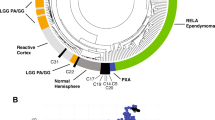Abstract
Astroblastomas are unique tumours with unresolved issues in terms of their origin, molecular biology, clinical behaviour, and response to treatment. To decipher the characteristics of this tumour, we reviewed cases histologically diagnosed as astroblastoma in our institute over the past 8 years, with immunohistochemistry, and performed fluorescence in situ hybridisation (FISH), for the newly emerged MN1 rearrangement which was reported in central nervous system high-grade neuroepithelial tumours. The mean age at diagnosis was 18.6 years with all cases seen in females and with supratentorial localisation. The tumours showed typical circumscription and bubbly appearance on imaging. The cohort included eight cases diagnosed as astroblastoma (two low grades; six anaplastic) based on histology and proliferative index. The tumours displayed characteristic astroblastic pseudorosettes with hyalinised vascular core and variable immunopositivity for glial fibrillary acidic protein, pan cytokeratin, and epithelial membrane antigen. MN1 break-apart by FISH was found in 5/8 of our cases (62.5%), which included 2 low-grade and 3 anaplastic tumours. Tumour recurrence was noted in three cases, with MN1 alteration in two. We account for one of the few series to study the MN1 rearrangement in astroblastoma and conclude that MN1 alteration is seen in a subset of these tumours.


Similar content being viewed by others
References
Aldape KD, Rosenblum MK, Brat DJ (2016) Astroblastoma. In: Louis DN, Ohgaki H, Wiestler OD (eds) WHO classification of tumours of the central nervous system, revised, 4th edn. IARC press, Lyon, pp 121–122
Brat DJ, Perry A (2018) Other glial neoplasms. In: Perry A, Brad DJ (eds) Practical surgical neuropathology. A diagnostic approach. Churchill Livingstone, Philadelphia, pp 171–182
Asha U, Mahadevan A, Sathiyabama D, Ravindra T, Sagar BKC, Bhat DI (2015) Lack of IDH1 mutation in astroblastomas suggests putative origin from ependymoglial cells? Neuropathology 35:303–311
Hammas N, Senhaji N, Lamrani MY, Bennis S, Chaoui EM, Fatemi H et al (2018) Astroblastoma—a rare and challenging tumor: a case report and review of the literature. J Med Case Repo 12:102
Brat DJ, Hirose Y, Cohen KJ, Feuerstein BG, Burger PC (2000) Astroblastoma: clinicopathologic features and chromosomal abnormalities defined by comparative genomic hybridization. Brain Pathol 10:342–352
Bonnin JM, Rubinstein LJ (1989) Astroblastomas: a pathological study of 23 tumors, with a postoperative follow-up in 13 patients. Neurosurgery 25:6–13
Bailey P, Cushing H (1926) A classification of the tumors of the Glioma group on a histogenetic basis with a correlated study of prognosis. JB Lippincott, Philadelphia
Bailey P, Bucy P (1930) Astroblastomas of the brain. Acta Psychiat Neurol 5:439–461
Scheithauer BW (2009) Development of the WHO classification of tumors of the central nervous system: a historical perspective. Brain Pathol 19:551–564
Sturm D, Orr BA, Toprak UH, Hovestadt V, Jones DTW, Capper D et al (2016) New brain tumor entities emerge from molecular classification of CNS-PNETs. Cell 164:1060–1072
Wood MD, Tihan T, Perry AJ et al (2018) Multimodal molecular analysis of astroblastoma enables reclassification of most cases into more specific molecular entities. Brain Pathol 28:192–202
Lehman NL, Usubalieva A, Lin T, Allen SJ, Tran Q, Mobley B et al (2019) Genomic analysis demonstrates that histologically-defined astroblastomas are molecularly heterogeneous and that tumors with MN1 rearrangement exhibit the most favorable prognosis. Acta Neuropathol Commun 7(1):42
Hirose T, Nobusawa S, Sugiyama K, Amatya V, Fujimoto N, Sasaki A et al (2018) Astroblastoma: a distinct tumor entity characterized by alterations of the X chromosome and MN1 rearrangement. Brain Pathol 28(5):684–694
Port JD, Brat DJ, Burger PC, Pomper MG (2002) Astroblastoma: radiologic–pathologic correlation and distinction from ependymoma. Am J Neuroradiol 23:243–247
Bell JW, Osborn AG, Salzman KL, Blaser SI, Jones BV, Chin SS (2007) Neuroradiologic characteristics of astroblastoma. Neuroradiology 49:203–209
Salvati M, D’Elia A, Brogna C, Frati A, Antonelli M, Giangaspero F et al (2009) Cerebral astroblastoma: analysis of six cases and critical review of treatment options. J Neurooncol 93:369–378
Lehman NL, Hattab EM, Mobley BC, Usubalieva A, Schniederjan MJ, McLendon RE et al (2017) Morphological and molecular features of astroblastoma, including BRAFV600E mutations, suggest an ontological relationship to other cortical-based gliomas of children and young adults. Neuro-oncolpgy 19:31–42
Shin SA, Ahn B, Kim SK, Kang HJ, Nobusawa S, Komori T et al (2018) Brainstem astroblastoma with MN1 translocation. Neuropathology 38(6):631–637
Yamada SM, Tomita Y, Shibui S et al (2018) Primary spinal cord astroblastoma: case report. J Neurosurg Spine 28:642–646
Acknowledgements
The authors wish to acknowledge the operating neurosurgeons for referring these cases for diagnosis. We thank Mr. Chandrashekar for technical assistance and Mr. K. Manjunath for helping with the illustrations.
Funding
None.
Author information
Authors and Affiliations
Corresponding author
Ethics declarations
Conflict of interest
The authors declare no conflict of interest.
Additional information
Publisher's Note
Springer Nature remains neutral with regard to jurisdictional claims in published maps and institutional affiliations.
Rights and permissions
About this article
Cite this article
Mhatre, R., Sugur, H.S., Nandeesh, B.N. et al. MN1 rearrangement in astroblastoma: study of eight cases and review of literature. Brain Tumor Pathol 36, 112–120 (2019). https://doi.org/10.1007/s10014-019-00346-x
Received:
Accepted:
Published:
Issue Date:
DOI: https://doi.org/10.1007/s10014-019-00346-x




